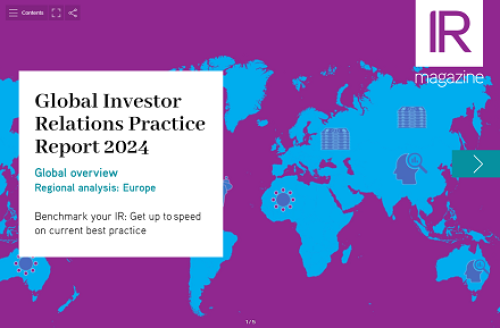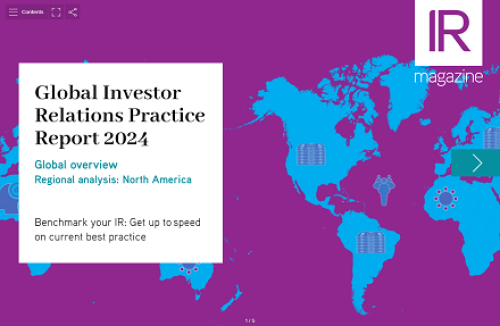IR practice has changed dramatically over the last 10 years
Ten years ago, IR in China was relatively simple: as long as a company made big profits, investors would automatically invest in it.
So all a company had to focus on to attract shareholders was generating profits, putting little or no effort into a dedicated investor relations department.
That is clearly no longer the case. At a basic level, Chinese companies have been pumping resources into IR. The average number of people in a Chinese IR team is 5.2, higher than both the global average (3.7) and the Asian regional average (4.3), according to the IR Magazine Global Practice Report 2011.
Meanwhile, annual IR budgets for mainland Chinese firms ($363,000) are well above the regional average ($336,000), albeit significantly below the global average ($561,000).
Beyond money and manpower, moreover, there has emerged a constituency of leading companies committed to pushing IR forward on the mainland.
True, many of these companies are listed in Hong Kong and have opted to locate some or all of their investor relations department in the special administrative region, but servicing the international capital markets in this way has evidently led to a transfer of IR knowledge and experience, which is subsequently being shipped northward.
Leading the way
Anta Sports is currently at the head of this group. The Chinese sportswear brand – the highest-ranked mainland Chinese company in IR Magazine’s Asia rankings – won six awards at last year’s IR Magazine Greater China Awards.
‘Since Anta listed in 2007, the management team has increasingly paid more attention to the development of IR,’ says Suki Wong, the new head of investor relations at Anta.
‘In order to better manage IR, the company has separated the IR department from the CFO’s management so the IR people report directly to the board of directors.’
Now that management teams have begun to appreciate the impact investors and analysts have on company share price, IR teams are in turn becoming more active in contacting the investment community to find out what drives investment decisions.
‘We are more active than before,’ says Helen Song, head of IR at Gome Electrical Appliances, ranked 29th in Greater China last year.
‘We contact investors after the announcement of a report, especially a [profits] warning report, because that is related to many factors including the change of macro situation. We actively communicate with analysts and companies to discover what they think about it.’
Macro picture
In China, as elsewhere, there can be macro influences on financial performance outside of a company’s control. Yet the government is particularly influential in China, often resulting in agenda-setting policies in sectors such as real estate.
‘The questions investors always ask are: how will we develop in the future and what are we doing to address the new controlling policies of government?’ says Tyche Shi, head of IR at Longfor Properties, ranked joint 20th in Greater China in 2011.
As nobody can predict what the government will decide in the future, the disclosure of accurate company information is even more crucial for the market.
During the research for last year’s IR Magazine Asia Awards, investors and analysts across the region were asked where IR needed the most improvement: greater transparency and disclosure emerged as the top concern across Asia, with respondents in China and Hong Kong reporting the highest levels of frustration with corporate opacity.
‘Generally IR here is terrible,’ said one Hong Kong sell-side analyst. ‘Companies take no advice from investors and they hide behind the excuse of selective disclosure. In the eight years I have been covering Asian companies, IR has not advanced at all.’
The good news is that there is a willingness among IROs in the region to keep improving their knowledge and abilities. Less encouraging are the difficulties some face in sourcing suitable educational outlets in the IR field.
‘We want to learn more about how to enhance investor relations,’ says Shi. ‘I look for training and books, but there isn’t anything about IR in the market. Attending more social events has become the main way to find out more in this area.’
Learning by example
An alternative – and similarly ad hoc – source of IR education adopted by leading IROs is to find examples of successful IR programs at other companies to follow.
‘We choose successful foreign companies in the retail industry to hear their experiences of IR,’ says Song. ‘For example, when Best Buy releases its reports, we try to understand how it answers questions about them from analysts and investors.’
Wong also selects other companies as a reference to develop her firm’s IR efforts. ‘We look at companies listed in Hong Kong: blue chips, winners of IR awards,’ she explains. ‘The experiences of all those companies are our reference point. We also take part in events within the IR community.’
The speed of China’s economic growth has, admittedly, slowed but Wong remains optimistic about the future of IR in China.
In her view, the relatively stable Chinese economy provides a good platform for companies to develop an investor relations program, laying the foundations for IR in China to become more proactive and interactive as a result.










